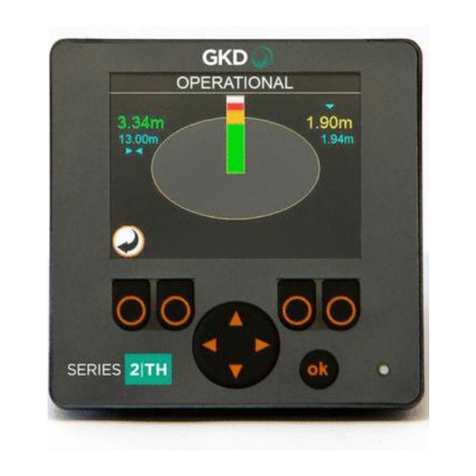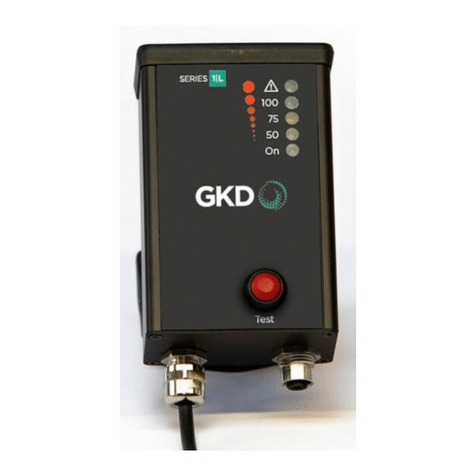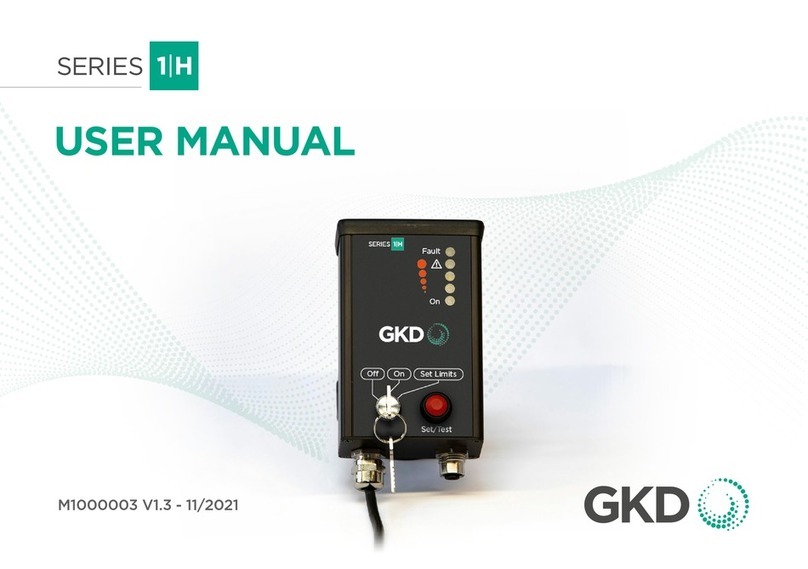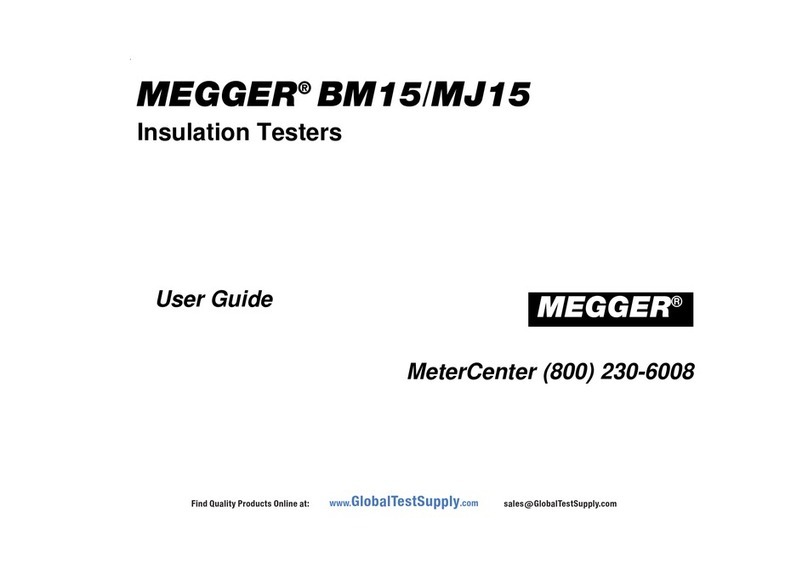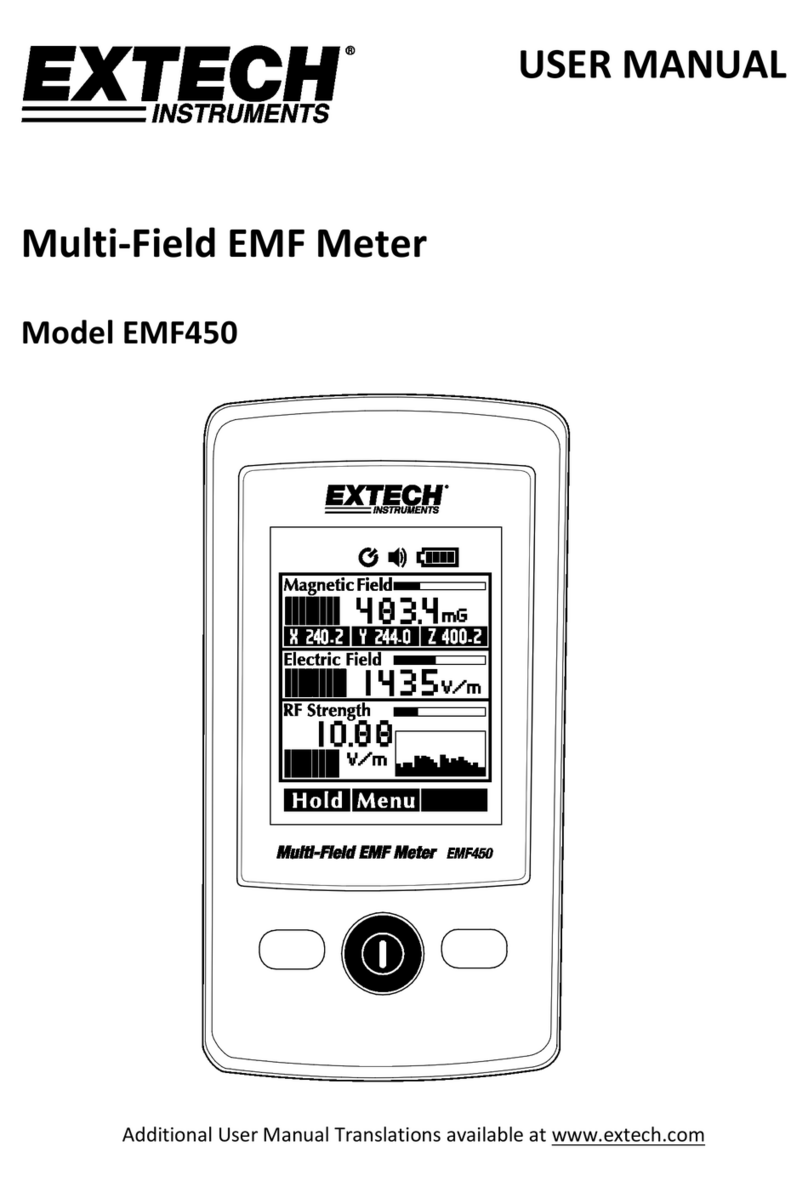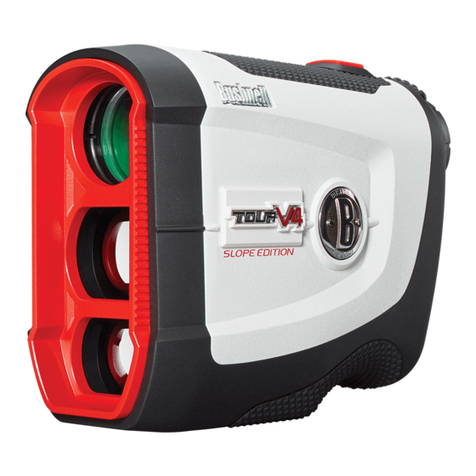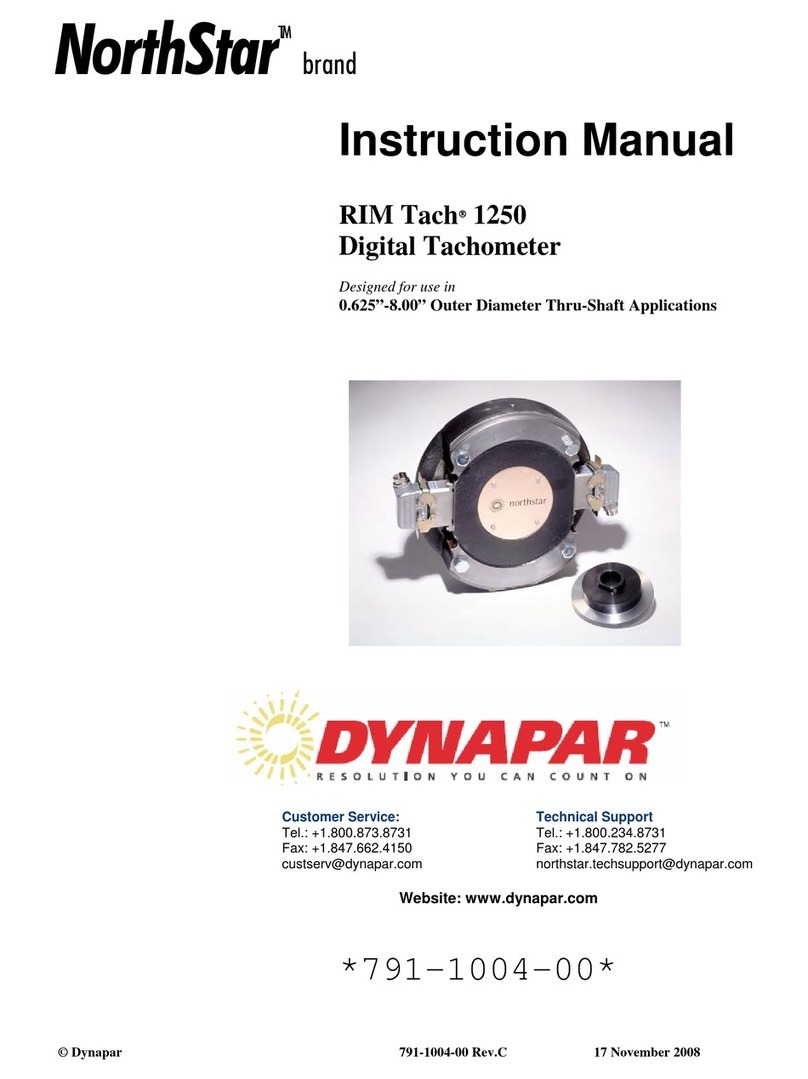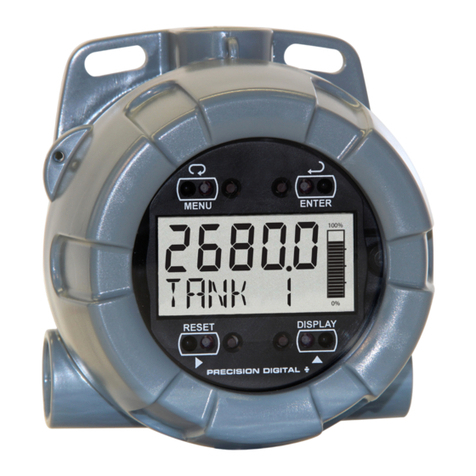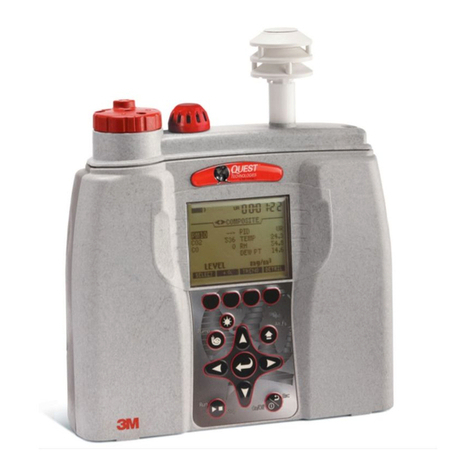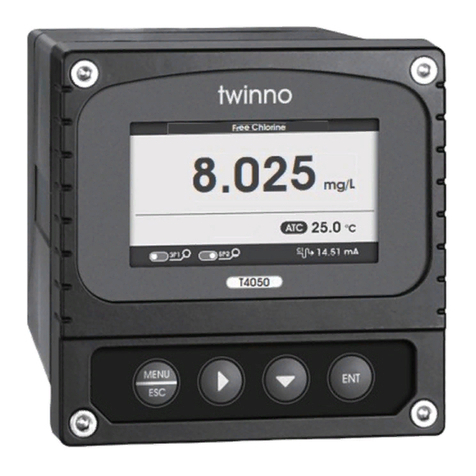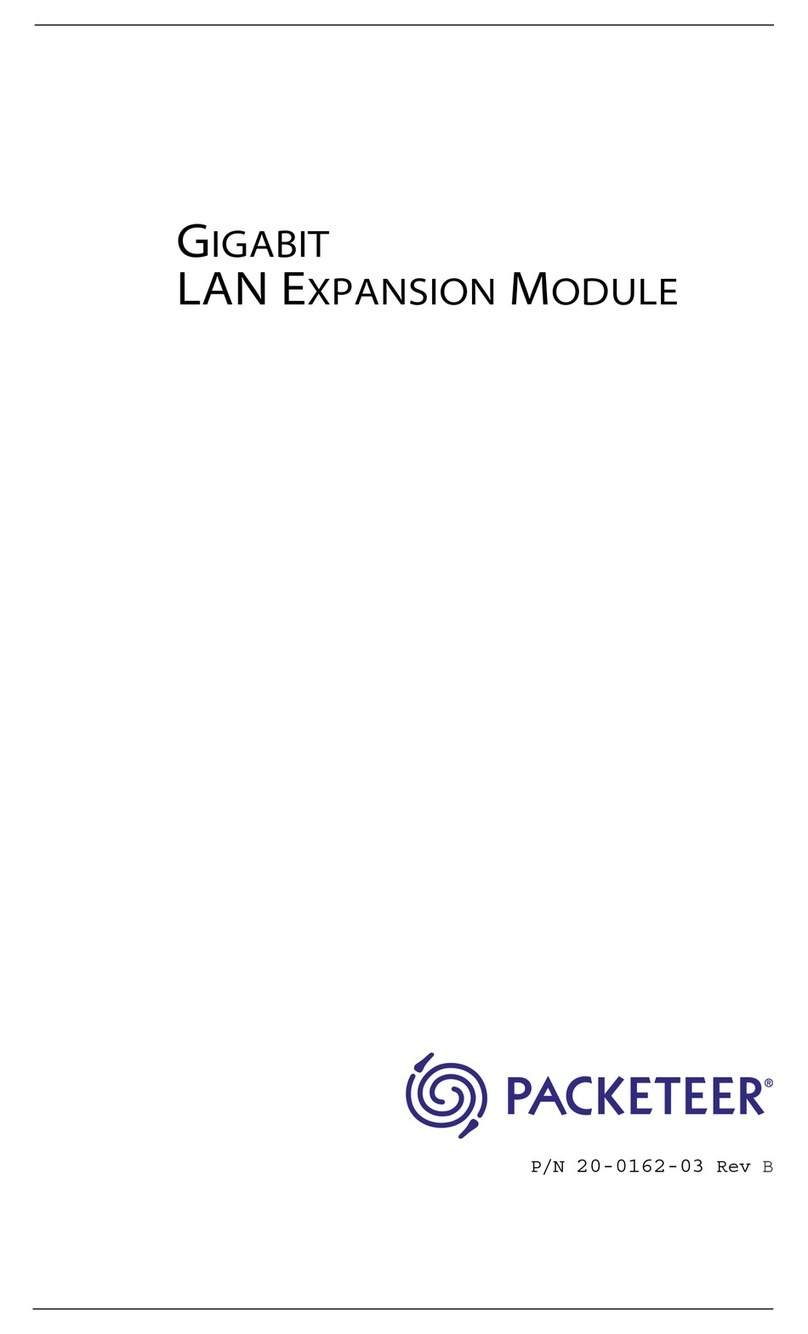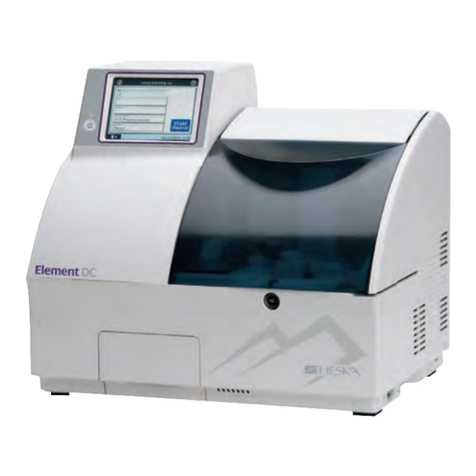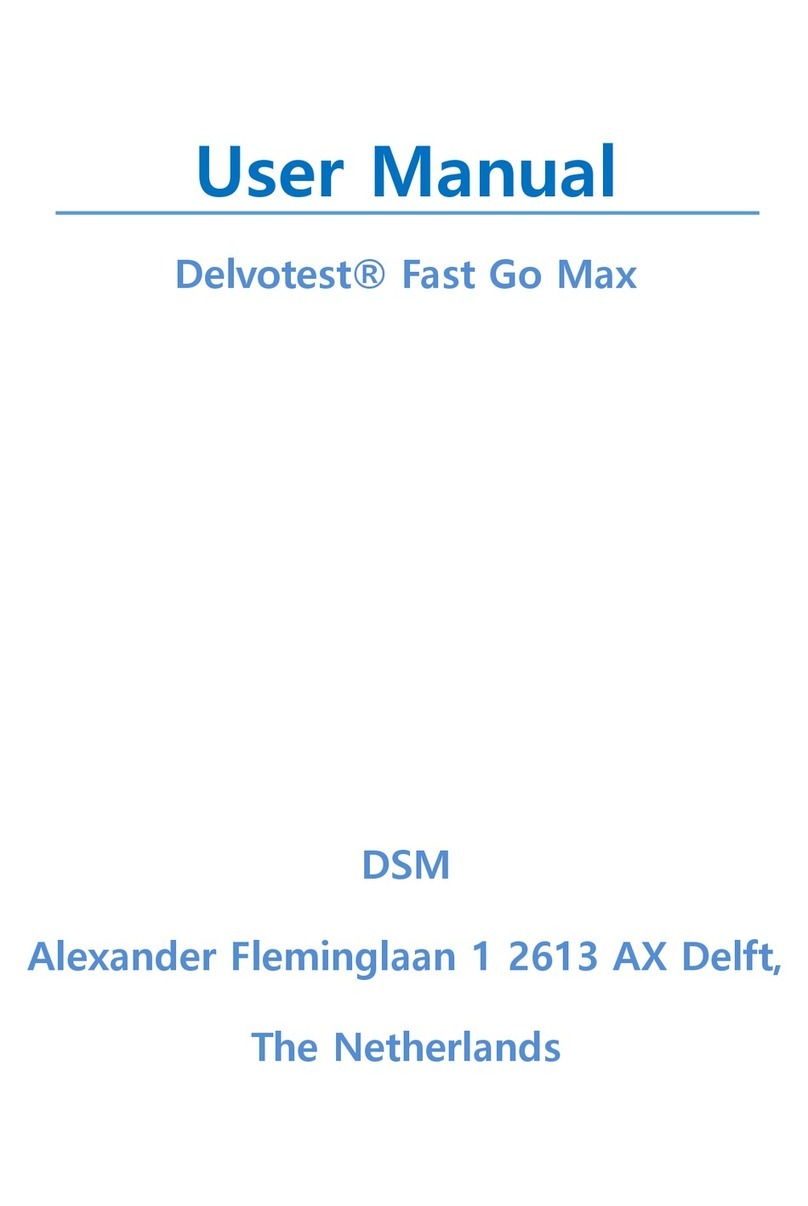GKD M4000001 User manual

USER MANUAL
M4000001 V2.3 - 03/2023

M4000001 V2.3 - 03/2023
www.sensorzone.io
2

www.sensorzone.io M4000001 V2.3 - 03/2023
3
CONTENTS
Page
1SAFETY AND WARNINGS 4
2GENERAL INTRODUCTION 8
3IN-CAB OPERATION 10
4 SYSTEMS FITTED WITH AN OPERATOR DISPLAY 12
5 SYSTEMS FITTED WITH A PUSH BUTTON DISPLAY 14
6TAG TEST UNIT 17

M4000001 V2.3 - 03/2023
www.s
4
1SAFETY AND WARNINGS
1.1
General
The SensorZone proximity warning system is supplied as an audible and/or visual alert system. It is not a
protective device. The system does not initiate or perform any safety related functions.
The SensorZone system is to be installed by professional installers who have completed appropriate training.
All electrical installation must follow local regulations and be made by certified installers.
The SensorZone proximity warning system is only to be used as a complement to existing Health and Safety
measures and practices.
The use of SensorZone does not replace professional machinery safe operating processes and procedures.
It is recommended that all personnel on site receive training as to the operational procedures of the SensorZone
system.
This device complies with part 15 of the FCC Rules. Operation is subject to the following two conditions: (1) This
device may not cause harmful interference, and (2) this device must accept any interference received, including
interference that may cause undesired operation.
www.sensorzone.io

www.sensorzone.io M4000001 V2.3 - 03/2023
5
1.2 Devices Containing Batteries
1.2.1 Tags
The tags contain Lithium Thionyl Chloride batteries having 0.7 grams of Lithium.
BATTERY WARNING:
Fire, explosion and severe burn hazard. Do not recharge, crush, disassemble, heat above 100ºC,
incinerate, or expose contents to water.
Follow all local regulations for the shipping of Lithium batteries.
For optimum battery life, tags should be stored in a cool, regulated (preferably around 20ºC and
never more than 30ºC), dry and ventilated area away from possible sources of heat and open
flames. Avoid exposure to direct sunlight for long periods of time.
The battery in the tag cannot be recharged, and attempting to do so can create fire, explosion and
severe burn hazard.
Tags that have reached end of life or are no longer required must be disposed of according to local
regulations.

M4000001 V2.3 - 03/2023
www.sensorzone.io
6
1.2.1.1 Damaged Tags
If you suspect the tag has suffered impact or maybe damaged in any way that may damage
the battery DO NOT USE.
The tag should be removed and quarantined.
DO NOT attempt to take the tag apart.
Follow local regulations for the safe disposal of units containing damaged batteries.
1.2.2 Base Stations and Tag Test Units
The base stations and tag test units contain a CR2032 Lithium coin cell.
BATTERY WARNING:
Fire, explosion and severe burn hazard. Do not recharge, crush, disassemble, heat above 100ºC,
incinerate, or expose contents to water.
For optimum battery life, base stations and tag test units should be stored in a cool, regulated
(preferably around 20ºC and never more than 30ºC), dry and ventilated area away from possible
sources of heat and open flames. Avoid exposure to direct sunlight for long periods of time.

www.sensorzone.io M4000001 V2.3 - 03/2023
7
1.3
1.4
Antenna
Personnel wearing Active Medical Implants should keep a minimum distance of 21cm from any
antenna.
Magnets
If fitted, the magnets used on the base station and antenna mounting plates and the beacon/sounder
are Neodymium magnets. These are much stronger than other magnets and care should be taken
handling them.
Keep a safe distance of at least 30cm from any device that can be damaged by magnetism. These
might include (but are not limited to) heart pacemakers, CRT displays and televisions, mechanical
watches, credit cards and magnetically stored media such as hard drives and video tapes.
Personnel using pacemakers should keep a safe distance from the magnets and should move away
from the magnets if they notice any effect.

M4000001 V2.3 - 03/2023
www.sensorzone.io
8
2GENERAL INTRODUCTION
The SensorZone Proximity Warning System (PWS) is complimentary to (and not a substitute for)
existing safe systems and procedures of work.
SensorZone is a robust, high-quality Collision Avoidance System – also known as a Proximity Warning
System – with a proven track record for improving safety in the workplace.
2.1 System Summary
SensorZone PWS generates a low frequency magnetic field, referr ed to as the exclusion zone, around the
antenna. This zone may be set at between 3m and 10m radius. The zone is nominally elliptical in shape.
The exclusion zone can be established by a single antenna for small/medium sized vehicles or with two
antenna for larger vehicles. Users should familiarise themselves with zones in use.
A tag entering the range of the exclusion zone detects the
magnetic field and replies to the base station. The tag will warn
the wearer with two pulses of vibration. The base station
initiates a visual and audible warning to the machine operator
via the display, as well as to personnel in the vicinity via external
sounders and beacons.
Every tag detection is recorded in the built-in Datalogger.

www.sensorzone.io M4000001 V2.3- 03/2023
9
2.2 System Components
•A base station
•One or two external antenna
•An operator display
•External sounder and visual warning
beacon (optional)
•SensorZone vibrating tag
Watch our SensorZone
introduction to find out
how the system works.

M4000001 V2.3 - 03/2023
www.sensorzone.io
10
3IN-CAB OPERATION
System Start Procedure
3.1 All machine operators are required to carry a tag.
1. The machine operator must be carrying a tag
2. Ensure no other tags are in the exclusion zone
3. Start the machine and the PWS system will automatically initialise
4. When the alarm/beep sounds (approximately 3 seconds after startup) press the
“Acknowledge” button.
5. If the “Acknowledge” button is not pressed within 15 seconds of the system start-up beep
then switch off and start the procedure again.

www.sensorzone.io M4000001 V2.3 - 03/2023
11
3.2 Troubleshooting
If the system does not initialise correctly the internal and external alarms will continuously sound
indicating an unauthorised operating state.
If the system does not enter the operating state when the “Acknowledge” button is pressed then
check the following:
1. That there are no additional tags in the exclusion zone (these maybe on pedestrians, drivers in
other machines nearby, or a tag left in the cab by a previous operator.
2. That your tag is functioning. Test your tag at a Tag Test station.
3. That the cable to the antenna is not disconnected or cut.
When the system is in operation, tags that enter the exclusion zone are automatically detected.

M4000001 V2.3 - 03/2023
www.sensorzone.io
12
!Warning
Tag Present
Low Tag Battery
New Tag
System On
Acknowledge
4.1 If a single tag enters the exclusion zone
•The Operator Display will flash the
“New Tag” and “! Warning” LEDs, and
Beep once every second.
•If an external alarm Sounder/Beacon is
connected to the Base Station both the
alarm will sound and the beacon will flash.
•This will repeat until the operator presses
the “Acknowledge” button and “Tag
Present” LED will be on.
•Once acknowledged the alarms
will be silenced and the beacon will stop
flashing. “Tag Present” LED will remain on
and “! Warning” LED will flash to show the
number of tags in the zone.
4SYSTEMS FITTED WITH AN OPERATOR DISPLAY

www.sensorzone.io M4000001 V2.3 - 03/2023
13
4.2 If more than one tag enters the exclusion zone
•The “! Warning” LED, “New Tag” LED, and Beep will indicate the number of tags that have entered
the field
•2 Tags detected = 2 flashes and 2 beeps.
•4 Tags detected = 4 flashes and 4 beeps.
•10 Tags detected = 10 flashes and 10 beeps.
•To acknowledge more than one tag, the “Acknowledge” button must be pressed for each tag. A
one-second pause is required between each press of the “Acknowledge” button.
Warning:
•Base Station and Display communications error: 5 beeps, 5 flashes on “! Warning” LED.
•No Driver Tag on power up: 10 Beeps, 10 Flashes on “! Warning” and “New Tag” LEDs.
•More than one tag in the zone on power up: Multiple beeps, multiple flashes on
“! Warning” and “New Tag” LEDs, with “Tag Present” LED constantly on.
•Antenna Fault: 12 beeps, 12 flashes on “! Warning” and “New Tag” LEDs.

M4000001 V2.3 - 03/2023
www.sensorzone.io
14
5SYSTEMS FITTED WITH A PUSH BUTTON DISPLAY
Acknowledge
Alarm LED
5.1 If a single tag enters the exclusion zone
•The Push Button Display will flash the
Alarm LED and Beep once every second.
•If an external alarm Sounder/Beacon is
connected to the Base Station both the
alarm will sound and the beacon will flash.
•This will repeat until the operator presses
the “Acknowledge” button.
•Once acknowledged the alarms will silence
and the beacon will stop flashing.

www.sensorzone.io M4000001 V2.3 - 03/2023
15
5.2 If more than one tag enters the exclusion zone
•The Alarm LED and Beep will indicate the number of tags that have entered the field:
•2 Tags detected = 2 flashes and 2 Beeps.
•4 Tags detected = 4 flashes and 4 beeps.
•10 Tags detected = 10 flashes and 10 beeps.
•To acknowledge more than one tag, the “Acknowledge” button
must be pressed for each tag. A one-second pause is required
between each press of the “Acknowledge” button.

M4000001 V2.3 - 03/2023
www.sensorzone.io
16
6OPERATIONAL SAFETY NOTES
6.1 External Sounder/Beacon
If the GKD SensorZone Sounder Beacon is selected the following operating modes will apply:
•System on = Beacon will flash slowly.
•Zone Incursion = Beacon flashes and alarm sounds.
•Incursion acknowledged = Beacon flashes slowly and no alarm sounding.
6.2 All Tag Users
•The tag has no user controls.
•Test your tag as recommended by your site management but not less than twice per day
–see Tag Test section on page 18.
•It is preferable to wear your tag in a way where it can easily be seen by others.
•Test your tag if you have any reason to think that it may have been damaged: dropped, exposed to
extreme temperature or otherwise physically damaged.
•Carry your tag at all times – it can be fixed to your helmet, a lanyard, or arm pouch.
If you enter an exclusion zone the tag will vibrate twice and the operator of the machine will be
warned of your presence.

www.sensorzone.io M4000001 V2.3 - 03/2023
17
6.3
6.4
STOP, LOOK, LISTEN.
Identify the machine (remembering it maybe behind you) and move away from it. An alarm on
the machine may also sound.
Note: your tag may not vibrate if you re-enter the exclusion zone of the same machine within a
short time. However, the operator will be warned and the alarms will sound.
Drivers
Once registered, your tag will not be detected by the machine you are operating.
It can still be detected by other machines.
•You are always protected.
•If you exit your machine, shut the machine down.
•If you come back into the field, the tag vibrates but the system on the machine does not alarm.

M4000001 V2.3 - 03/2023
www.sensorzone.io
18
7TAG TEST UNIT
7.1 All tags must be tested daily
Tags should be tested at the beginning and end of all work periods and whenever entering
the site.
•Make sure you are aware of the tag test locations on your site.
•The Tag Test Unit ensures the tags are operating correctly, and will alert the user to a low battery or
inoperative tag
7.2 Tag Test Procedure:
•Place the tag on or near the Tag Test unit
•The unit will Beep to indicate the presence of a tag and the “Tag Seen” LED will light.
•Press the “Acknowledge” button (if fitted) to log the tag.
A short pause should be left before the next tag is tested.

www.sensorzone.io M4000001 V2.3 - 03/2023
19
Power
connection
Acknowledge
button
Tag Seen
indicator
Battery Low
indicator

GKD Technologies reserve the
right to change these instructions in
line with the policy of continuous improvement.
17 Cobham Road, Ferndown Industrial Estate, Wimborne, Dorset, UK. BH21 7PE
+44 (0)1202 861 961 [email protected] www.sensorzone.io
©GKD Technologies - M4000001 V2.3 - 03/2023
Table of contents
Other GKD Measuring Instrument manuals
